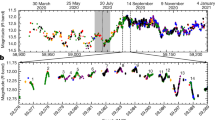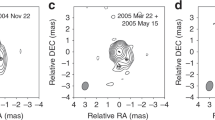Abstract
The well known object BL Lacerate is the prototype of a class of compact extragalactic sources which display rapid flux and polarization changes at radio and optical wavelengths and a nearly featureless optical spectrum1. After a period of relative quiescence, BL Lac has recently undergone a violent outburst at radio wavelengths, accompanied by rapid changes in degree of polarization and position angle (Fig. 1)2,3. For a better understanding of the physical mechanism responsible for the variable emission, we have mapped the radio structure at 5 and 10.6 GHz at three epochs during the large flux outburst of 1980 with an intercontinental VLBI array using telescopes in Bonn, West Germany; Green Bank, West Virginia; Westford, Massachusetts; Fort Davis, Texas; and Owens Valley, California. The synthesized beam had a resolution of about 1.0 m arc s at λ 6 cm and 0.5 m arc s at λ 2.8 cm, corresponding to linear sizes of 5.9 and 2.9 lyr (light year) at the source (using a redshift4 of 0.0695 and a Hubble constant of 55 km s−1 Mpc−1). We show here that comparison of the size and flux density of the core component with the flux history provides evidence for relativistic beaming effects, independent of detailed model considerations. The flux densities shown in Fig. 1 were obtained at the University of Michigan radio observatory.
This is a preview of subscription content, access via your institution
Access options
Subscribe to this journal
Receive 51 print issues and online access
$199.00 per year
only $3.90 per issue
Buy this article
- Purchase on Springer Link
- Instant access to full article PDF
Prices may be subject to local taxes which are calculated during checkout
Similar content being viewed by others
References
Stein, W. A. in Pittsburgh Conf. on BL Objects (University of Pittsburgh, Pennsylvania, 1978).
Aller, M. F., Aller, H. D. & Hodge, P. E. Bull. Am. astr. Soc. 12, 803 (1981).
Aller, H. D., Aller, M. F. & Hodge, P. E. Astr. J. 86, 325 (1981).
Miller, J. S., French, H. B. & Hawley, S. A. Astrophys. J. Lett. 219, L85 (1978).
Clark, B. G. IEEE 61, 1242 (1973).
Readhead, A. C. S. & Wilkinson, P. N. Astrophys. J. 223, 25 (1978).
Clark, B. G. et al. Astrophys. J. Lett. 182, L57 (1973).
Kellermann, K. I. et al. Astrophys. J. 211, 658 (1977).
Shaffer, D. B. in Pittsburgh Conf. on BL Objects (University of Pittsburgh, Pennsylvania, 1978).
Pearson, T. J. & Readhead, A. C. S. Astrophys. J. 248, 671 (1981).
Blandford, R. D. & Königl, A. Astrophys. J. 232, 34 (1979).
Readhead, A. C. S. Phys. Scr. 21, 662 (1980).
Scheuer, P. A. G. & Readhead, A. C. S. Nature 277, 182 (1979).
Kellermann, K. I. & Pauliny-Toth, I. I. K. A. Rev. Astr. Astrophys. (in the press).
Author information
Authors and Affiliations
Rights and permissions
About this article
Cite this article
Mutel, R., Aller, H. & Phillips, R. Milliarcsecond structure of BL Lac during outburst. Nature 294, 236–238 (1981). https://doi.org/10.1038/294236a0
Received:
Accepted:
Issue Date:
DOI: https://doi.org/10.1038/294236a0
This article is cited by
-
MERLIN observations of superluminal radio sources
Nature (1982)
Comments
By submitting a comment you agree to abide by our Terms and Community Guidelines. If you find something abusive or that does not comply with our terms or guidelines please flag it as inappropriate.



